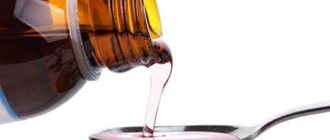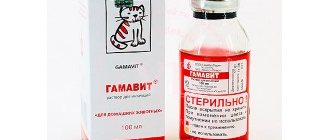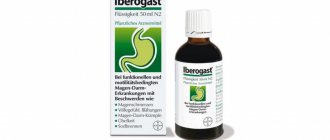Release form, packaging and composition of the drug Clinical-pharmacological group Pharmaco-therapeutic group Pharmacological action Indications for use Method of administration and doses Side effects Contraindications for use Use in children Special instructions Drug interactions
Registration Certificate Holder:
Orfan Remedi, LLC (Russia)
ATX Code:
L01XX35
Active substance:
anagrelide
Dosage form:
Anagrelide
| The drug is available with a prescription | Anagrelide | Capsules reg. No.: LP-005784 dated 09.10.19 - Valid |
Release form, packaging and composition of the drug Anagrelide
Capsules
hard gelatin No. 4, cap and body red-brown; the contents of the capsules are white or almost white powder.
| 1 caps. | |
| anagrelide hydrochloride monohydrate | 0.61 mg, |
| which corresponds to the content of anagrelide | 0.5 mg |
Excipients
: lactose monohydrate - 53.74 mg, lactose - 65.76 mg, povidone K30 - 3.75 mg, crospovidone - 3 mg, microcrystalline cellulose (VIVAPUR® 102) - 22.5 mg, magnesium stearate - 0.75 mg.
Composition of the capsule (body and cap)
: gelatin - 37.3033 mg, iron dye red oxide (E172) - 0.57 mg, titanium dioxide (E171) - 0.1267 mg.
100 pieces. — bottles made of high-density polyethylene (1) white, opaque — cardboard packs.
pharmachologic effect
A drug for the treatment of thrombocythemia, a PDE3 inhibitor of cyclic adenosine monophosphate (AMP). The specific mechanism of action of anagrelide leading to a decrease in platelet counts has not been fully studied. It has now been established that anagrelide selectively acts on platelets in vitro and in vivo.
In vitro studies of megakaryocyte formation have shown that in humans, the inhibition of platelet formation caused by anagrelide is associated with a delay in megakaryocyte maturation, a decrease in their size and density. Similar in vivo effects were found in bone marrow biopsies from patients treated with anagrelide.
Pharmacological properties of the drug Anagrelide
A specific agent that causes a dose-dependent and reversible decrease in the number of platelets in peripheral blood. The mechanism of action is not fully understood. Data from clinical studies indicate that anagrelide inhibits hypermaturation of megakaryocytes in a dose-dependent manner. In blood samples obtained from healthy volunteers taking anagrelide, a disturbance in the postmitotic phase of megakaryocyte development, a decrease in their size and ploidy, was noted. In therapeutic doses, anagrelide does not lead to significant changes in the number of leukocytes and causes a slight and clinically insignificant decrease in the number of erythrocytes. Anagrelide inhibits phosphodiesterase type III (PDE III) of cyclic AMP (cAMP). PDE III cAMP inhibitors can inhibit platelet aggregation, but significant inhibition of platelet aggregation is observed when used in higher doses than required to reduce platelet counts. The use of anagrelide does not lead to a significant change in parameters such as blood clotting time and platelet lifespan, and the morphology of the bone marrow does not change. The use of anagrelide does not affect blood pressure, heart rate, ECG, or urine test results. Anagrelide is rapidly absorbed from the gastrointestinal tract when taken orally. The degree of absorption in the intestine is 76%. The pharmacokinetics of ananagrelide in the dose range of 0.5–2.0 mg is linear. When taking anagrelide in a dose of 0.5 mg on an empty stomach, the half-life is 1.3 hours. The drug does not accumulate with repeated doses, is rapidly metabolized, the main metabolite is excreted in the urine within 24 hours, less than 1% is excreted unchanged. Eating at the same time slows down the absorption of the substance. When taking anagrelide at a dose of 0.5 mg after meals, a moderate decrease in bioavailability was observed by an average of 14%, while the half-life increased to 1.8 hours.
Directions for use and doses
The method of administration and dosage regimen of a particular drug depend on its release form and other factors. The optimal dosage regimen is determined by the doctor. The compliance of the dosage form of a particular drug with the indications for use and dosage regimen should be strictly observed.
High-risk patients with essential thrombocythemia are defined as those having one or more of the following characteristics: age > 60 years; platelet count > 1000 × 109/l; presence of thrombo-hemorrhagic complications in the anamnesis.
Taken orally. The recommended initial dose is 1 mg/day in 2 divided doses of 500 mcg. The initial dose should be taken for at least 1 week. Thereafter, the dose can be gradually increased on an individual basis until the minimum effective dose is achieved that reduces and/or maintains platelet count to/at a level less than 600 × 109/L, the optimal level being between 150 × 109/L and 400 × 109/L. The rate of dose increase should not exceed 500 mcg/day for a week, the maximum single dose is 2.5 mg.
The effect of anagrelide should be regularly assessed. If the initial dose exceeds 1 mg/day, platelet counts should be determined every 2 days in the first week and then at least once a week until a stable maintenance dose is achieved. Typically, a drop in platelet counts is observed on the 14-21st day after the start of treatment, and in most patients, a sufficient therapeutic effect is achieved and maintained at a dose of 1-3 mg/day.
Thromboreductin (Anagrelide) capsules 0.5 mg 100 pcs - Instructions
Compound
The active ingredient is 0.5 mg of anagrelide in the form of hydrochloride.
Other ingredients: lactose monohydrate, povidone, crospovidone, microcrystalline cellulose, magnesium stearate, coating: titanium dioxide E 171, indigo red E 132, gelatin, purified water.
Release form
The medicine is produced in hard capsules filled with white powder. Supplied in packs of 100 capsules each.
pharmachologic effect
Anagrelide contained in the drug causes a dose-dependent decrease in platelet count. The mechanism of action is not clear. Anagrelide exerts its effect by reducing the size and ploidy of megakaryocytes during the postmitotic phase of maturation. Anagrelide did not cause significant changes in white blood cells or coagulation parameters, but minor changes in red blood cells were observed. At high non-therapeutic doses, anagrelide inhibits c-AMP phosphodiesterase and ADP and collagen-induced platelet aggregation. The mechanism of action is species specific in humans and there is no information on platelet reduction in any animal models. For this reason, anagrelide is believed to act through a metabolite that is formed in the human body.
Pharmacokinetics
Anagrelide is well absorbed after oral administration, its bioavailability is 70%. The maximum concentration is reached after 1-2 hours.
The distribution of anagrelide is unknown with a volume of distribution of 120 L/kg.
The substance is metabolized in the liver by cytochrome P450 1A2 (CYP1A2) to two major metabolites, 3-hydroxyanagrelide and RL603.
About 1% of anadrelide is excreted unchanged in the urine, while about 3% and 16-20% of the administered dose are excreted as the metabolites 3-hydroxyanagrelide and RL603, respectively.
Indications for use
Thromboreductin is used in the treatment of essential thrombocythemia.
Contraindications
Restrictions on the use of the drug are: hypersensitivity to the composition of the drug, grade 3 cardiovascular disease, severe renal failure and moderate or severe liver failure.
Side effects
The most common negative reactions are manifested in the form of: headache, anemia, ecchymosis, edema, dizziness, paresthesia, insomnia, palpitations, tachycardia, hypertension, nosebleeds, nausea, diarrhea, dyspepsia, eczema, back pain, increased fatigue.
Drug interactions
The following drugs were used simultaneously with anagrelide: acetylsalicylic acid, acetaminophen, beta blocker, angiotensin-converting enzyme (ACE) inhibitors, clopidogrel, coumarin, folic acid, amlodipine, carbamazepine, hydrochlorothiazide, indapamide, furosemide, iron supplements, iron supplements, iron supplements. simvastatin, ticlopidine, ranitidine, hydroxyurea, allopurinol and digoxin. With the exception of acetylsalicylic acid (increased risk of bleeding), no significant interactions were observed.
Application and dosage
The daily dose is determined individually for the patient depending on the response to treatment. The maximum permissible dose should not exceed 5 mg. Treatment should begin with 0.5 mg per day, and this dose can be increased weekly until a positive response is obtained. Treatment should be carried out by a doctor experienced in treating essential thrombocythemia.
Overdose
Intoxication is manifested by a pronounced decrease in blood pressure and tachycardia. Dizziness may also occur. Reports of overdose have also included symptoms of sinus tachycardia and vomiting.
special instructions
Thromboreductin should be used with caution in people with cardiovascular disease. People with kidney and/or liver disease should be monitored frequently, especially at the beginning of treatment. The medication may reduce the absorption of oral contraceptives.
Use during pregnancy and breastfeeding
Appointment is prohibited.
Impact on the ability to drive vehicles and operate machinery
Thromboreductin may cause dizziness, so you should not drive or use machinery until the side effects go away.
Terms of sale
As prescribed by a doctor.
Storage conditions
The medication must be stored in a temperature range from 15 to 25 degrees Celsius, in a place out of reach of children.
Side effect
From the hematopoietic system:
often - anemia; uncommon - thrombocytopenia, pancytopenia, ecchymosis, bleeding.
From the side of metabolism:
often - fluid retention; infrequently - edema, weight loss; rarely - weight gain.
From the nervous system:
very often - headache; often - dizziness; uncommon - paresthesia, insomnia, depression, confusion, hypoesthesia, nervousness, dry mouth, amnesia; rarely - drowsiness, loss of coordination, dysarthria, migraine.
From the senses:
rarely - visual impairment, diplopia, tinnitus.
From the cardiovascular system:
often - palpitations, tachycardia; uncommon - congestive heart failure, increased blood pressure, arrhythmia, atrial fibrillation, supraventricular tachycardia, ventricular tachycardia, fainting; rarely - angina pectoris, myocardial infarction, cardiomegaly, cardiomyopathy, pericardial effusion, vasodilation, orthostatic hypotension.
From the respiratory system:
uncommon - shortness of breath, nosebleeds, pleural effusion, pneumonia; rarely - pulmonary artery hypertension, infiltrates in the lungs; unknown - allergic alveolitis.
From the digestive system:
often - nausea, diarrhea, abdominal pain, flatulence, vomiting; uncommon - dyspepsia, anorexia, pancreatitis, constipation, gastrointestinal bleeding, gastrointestinal upset; rarely - colitis, gastritis, bleeding gums.
From the liver and biliary tract:
infrequently - increased activity of liver enzymes; unknown - hepatitis.
For the skin and subcutaneous tissues:
often - rash; uncommon - alopecia, skin discoloration, itching; rarely - dry skin.
From the musculoskeletal system:
uncommon - myalgia, arthralgia, back pain.
From the genitourinary system:
infrequently - impotence; rarely - bedwetting, renal failure; unknown - tubulointerstitial nephritis.
Common disorders:
often - fatigue; uncommon - chest pain, weakness, chills, general malaise, fever; rarely - asthenia, pain, flu-like syndrome.
From the laboratory parameters:
rarely - increased creatinine concentration in the blood.
Anagrelide drug overdose, symptoms and treatment
Since the decrease in platelet count during anagrelide therapy is dose-dependent, it can be expected that an overdose will lead to the development of thrombocytopenia, which can cause hemorrhagic complications. In case of overdose, toxic manifestations from the cardiovascular system and central nervous system are possible. It is necessary to monitor the number of platelets in peripheral blood; Anagrelide should be discontinued until the indicator normalizes.
List of pharmacies where you can buy Anagrelide:
- Moscow
- Saint Petersburg
special instructions
Before using anagrelide in patients with mild hepatic impairment, the benefits should be weighed against the possible risks of use. It is not recommended to use anagrelide when transaminase activity increases more than 5 times higher than ULN. Before using anagrelide in patients with impaired renal function, the benefits and possible risks of use should be weighed. During treatment, careful monitoring of the patient’s clinical condition is necessary, including a complete clinical blood count (hemoglobin , leukocytes, platelets), determination of the activity of liver enzymes ALT and AST, as well as assessment of renal function (determining the concentration of creatinine and urea in the blood serum). Platelet levels usually increase 4 days after discontinuation of anagrelide and return to baseline levels after 10-14 days .Cases of cardiomegaly and congestive heart failure have been described. In patients of any age with known or suspected heart disease, anagrelide should be used with caution and only if the expected benefit of treatment outweighs the possible risk. Anagrelide is a PDE3 inhibitor of cyclic AMP and has a positive inotropic effect, therefore, before starting treatment, it is recommended to conduct an examination of the cardiovascular system, including, if necessary, echocardiography and ECG. During treatment, the occurrence of cardiovascular events, which may require additional examination, should be monitored. It is not recommended to use anagrelide simultaneously with other PDE3 inhibitors, incl. with milrinone, amrinone, enoximon, olprinon and cilostazol. Use in pediatrics
Experience with anagrelide in children is limited.
Anagrelide should be used in children with caution in children over 7 years of age. Impact on the ability to drive vehicles and machinery
During the treatment period, patients are advised to refrain from driving vehicles and engaging in other potentially hazardous activities that require increased concentration and speed of psychomotor reactions, because anagrelide may cause dizziness and other side effects.
Drug interactions
Anagrelide is metabolized mainly by the CYP1A2 isoenzyme. Some drugs, including fluvoxamine and omeprazole, are known to inhibit the activity of the CYP1A2 isoenzyme, so such drugs could theoretically adversely affect the clearance of anagrelide. Anagrelide exhibits the properties of a weak inhibitor of the CYP1A2 isoenzyme and theoretically may interact with other drugs that are cleared by the same mechanism, for example, with theophylline. Anagrelide is a PDE3 inhibitor. It can enhance the effects of drugs that have the same effect, incl. inotropic drugs milrinone, amrinone, enoximon, olprinone and cilostazol. At doses recommended for the treatment of essential thrombocythemia, anagrelide can theoretically enhance the effects of other drugs that inhibit or alter platelet function, for example, acetylsalicylic acid. A clinical interaction study in healthy volunteers showed that multiple Taking anagrelide at a dose of 1 mg 1 time / day together with acetylsalicylic acid 75 mg 1 time / day may enhance the inhibition of platelet aggregation caused by these drugs compared to taking acetylsalicylic acid alone. Therefore, due to the lack of relevant data for patients with essential thrombocythemia, the possible risk should be assessed before using these drugs together, especially for patients with a high risk of bleeding. In some patients, anagrelide may cause intestinal dysfunction and may interfere with the absorption of oral hormonal contraceptives. food slows down the absorption of anagrelide, but does not have a significant effect on its systemic effect.



